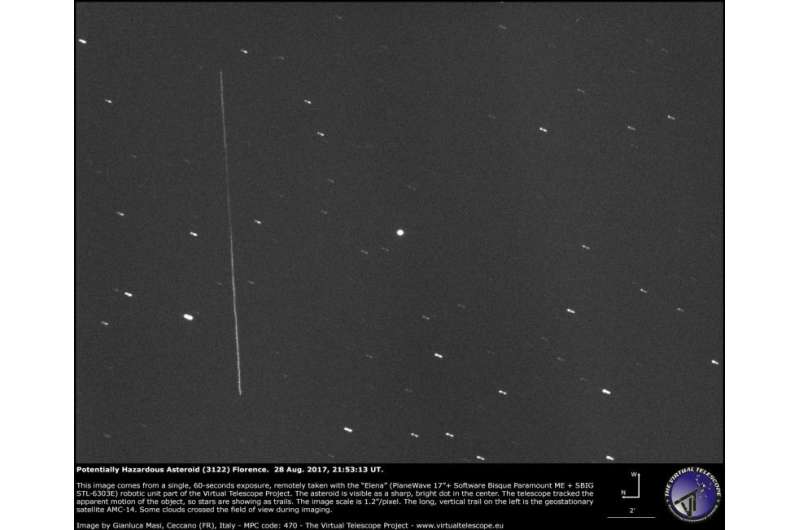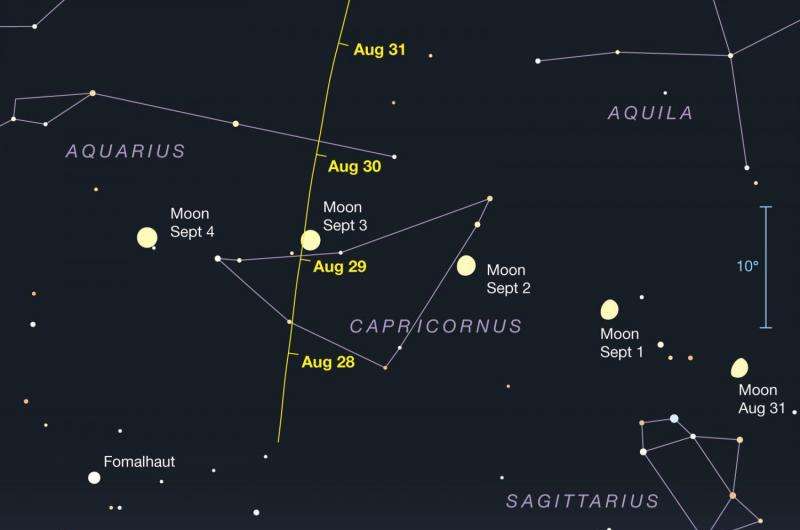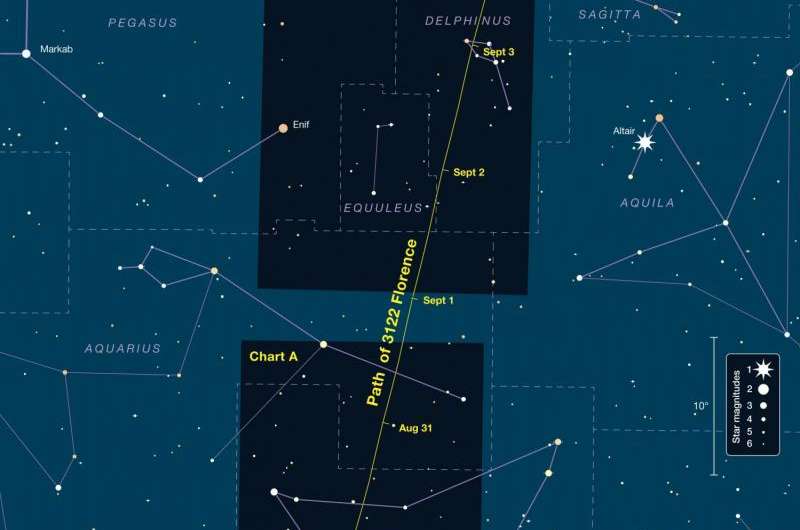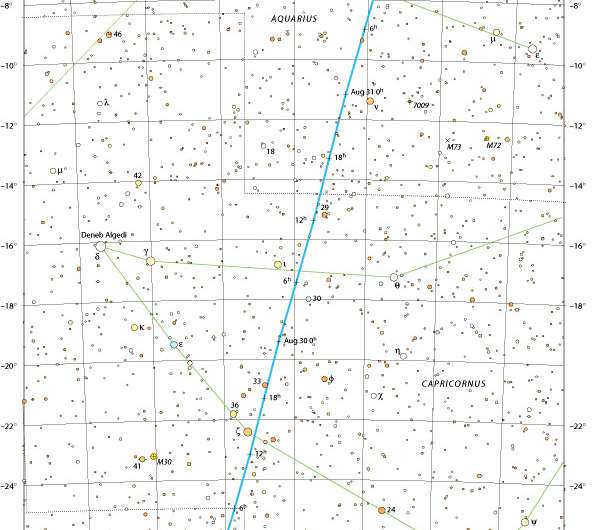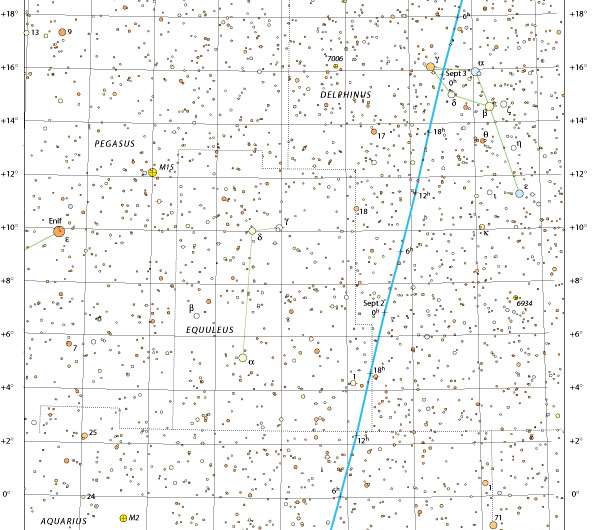A 60-second exposure with a large amateur telescope on August 28, 2017, records asteroid 3122 Florence (bright dot in center). The telescope tracked the apparent motion of the object, so stars are trailing. The long vertical trail on the left is the geostationary satellite AMC-14. The asteroid was about 5 million miles (8 million km) from Earth. Credit: Gianluca Masi / Virtual Telescope Project
When astronomer Bobby Bus discovered an asteroid passing through the inner solar system on March 2, 1981, it was bright enough to record in his telescope's photos despite being more than 145 million miles away. This week that same body, now bearing the catalog number 3122 and named to honor Florence Nightingale, is cruising by us at a distance of just 4.4 million miles (7 million km). That's closer than it's been since 1890 or will be again until at least 2500.
Florence will not pose any danger to Earth, but all this week the asteroid will appear as bright as a 9th-magnitude star. "Despite some interference from moonlight, 3122 Florence should be fairly easy to spot in even modest backyard telescopes," notes Kelly Beatty, a senior editor at Sky & Telescope magazine.
To locate Florence, you'll need an accurate sky chart that plots the asteroid's motion among the background stars night to night. The best time to view will be late evening, when it's high overhead. Although Florence reaches peak brightness (magnitude 8.7) late on Thursday night (August 31st and early on September 1st), it should remain nearly this bright for several days before and afterward.
Sky & Telescope has prepared four detailed charts to help observers locate 3122 Florence this week. Two of these show the asteroid's general motion northward among the constellations. Two more show small areas of sky, plotting all stars brighter than magnitude 9.5, for North American observers on the evenings of August 29-31 and September 1-3. Note that the detailed charts are labeled for Universal Time (GMT), and you'll have to apply a time-zone correction for your location (for example, 0h UT on August 31st corresponds to 8 pm EDT on August 30th).
During late August and early September, the near-Earth asteroid 3122 Florence passes Earth as close as 4.4 million miles from Earth. It will be bright enough to spot in modest backyard telescopes. Note that the labeled dates on this chart mark the asteroid's location at 11 p.m. Eastern Daylight Time; adjust to your time zone accordingly. Credit: Sky & Telescope
During its visit, Florence will be traveling roughly south to north, crossing through the constellations Capricornus, Aquarius, Delphinus, Vulpecula, and Cygnus. An especially good opportunity occurs at about 8 pm Eastern Daylight Time on Saturday evening, September 2nd, when the asteroid crosses the quartet of 4th-magnitude stars that mark the head of Delphinus, the Dolphin. It will be gliding northward by a little less than the full Moon's diameter each hour, motion that should be obvious by watching the asteroid's starlike pinpoint through a telescope for just a few minutes.
Florence appears this bright, despite being far away, both because it's among the largest near-Earth asteroids (2.7 miles across) and it has a fairly bright surface that reflects more than 20 percent of the sunlight that strikes it. (For comparison, the Moon's average reflectivity is just 12 percent.) Although it rotates in just 2.4 hours, this asteroid must be nearly spherical because its brightness varies by no more than about 11 percent—too small a change to pick up by eye.
-
This chart shows the northward motion of asteroid 3122 Florence through several constellations during late August and early September. Note that the labeled dates on this chart mark the asteroid's location at 0:00 Universal Time (midnight GMT) on the listed date. These correspond to 8 p.m. Eastern Daylight Time on the previous date; adjust to your time zone accordingly. The two dark areas, labeled Chart A and Chart B, correspond to the detailed charts below. Credit: Sky & Telescope
-
This chart shows the northward motion of asteroid 3122 Florence through the constellations Capricornus and Aquarius on the evenings of August 29–31 in North America. Stars are plotted to magnitude 9.5, fainter than the asteroid will appear. Note that the labeled dates on this chart mark the asteroid's location at 0:00 Universal Time (midnight GMT) on the listed date. These correspond to 8 p.,m Eastern Daylight Time on the previous date; adjust to your time zone accordingly. Credit: Sky & Telescope
-
This chart shows the northward motion of asteroid 3122 Florence through the constellations Aquarius and Delphinus on the evenings of September 1–3 in North America. Stars are plotted to magnitude 9.5, fainter than the asteroid will appear. Note that the labeled dates on this chart mark the asteroid's location at 0:00 Universal Time (midnight GMT) on the listed date. These correspond to 8 p.,m Eastern Daylight Time on the previous date; adjust to your time zone accordingly. Credit: Sky & Telescope
Provided by Sky & Telescope
